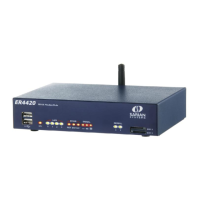Manage files
Digi TransPort User Guide 777
Manage files from the command line interface
Use the following commands from the command line to perform file management tasks.
COPY command: Copy a file
The copy command makes a copy of a file. The format is:
copy <filename> <newfilename>
<filename>
The name of an existing file.
<newfilename>
The name of the new copy that will be created.
DEL command: Delete a file
The del command deletes files from the filing system. The format is:
del <filename>
<filename>
The name of an existing file.
You can also use wild cards in the filename in order to delete several files at once. The *
character can represent one or more characters in the filename. For example, del fw*.txt will
delete files fw.txt and fwstat.txt. The del command returns OK if files have been deleted, or
ERROR if no matching files have been found.
DIR command: List the file directory
The dir command displays the file directory. For example:
dir
direct 60720 ro 11:30:41, 31 Jan 2011 CRC ???
sbios 524288 ro 11:30:43, 31 Jan 2011 CRC 6ba8
mirror 60720 ro 11:30:41, 31 Jan 2011 CRC ???
image 4300995 rw 15:22:23, 31 Jan 2011 CRC ab19
sregs.dat 4096 rw 11:30:41, 31 Jan 2011 CRC 08b2
x3prof 4096 rw 11:30:41, 31 Jan 2011 CRC bb5f
CAcert.cer 1371 rw 11:30:41, 31 Jan 2011 CRC 6764
Each line shows:
• The file name and extension, if any
• The file size, in bytes
• The read/write status: ro=read only; rw=read/write
• The time/date of creation and the CRC value
Note File write operations are carried out as a background task and can be relatively slow due
to the constraints of FLASH memory. As a result, the file directory may only be updated
several seconds after a particular file operation has been carried out.

